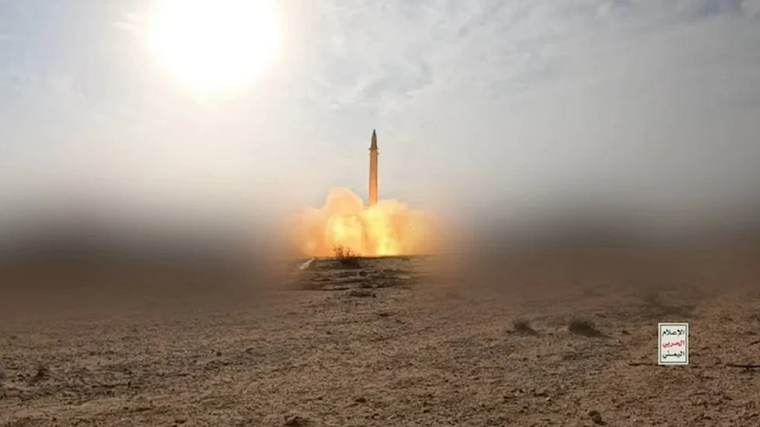
The Yemeni Armed Forces announced on Friday that their missile force carried out a military operation targeting Lod Airport in occupied Jaffa with a hypersonic ballistic missile, named “Palestine 2,” and two drones.
In a statement, Armed Forces spokesperson Brigadier General Yahya Saree confirmed that the missile bypassed Zionist interception systems and successfully hit its target. He said the strike caused major disruption within Zionist ranks, forced millions of settlers into shelters, and led to the suspension of airport operations.
He added that the Air Force carried out two additional operations using drones, targeting military and vital sites in Jaffa and Ashkelon, stressing that both achieved their objectives.
Saree concluded that the operation came “in victory for the oppressed Palestinian people and their resistance, and in response to Zionist crimes of genocide and starvation against our people in Gaza.”
He reaffirmed that “Yemen, with its loyal people, fighting army, and faithful leadership, stands with you until the aggression ends and the siege is lifted,” praising Palestinian heroism and sacrifice in confronting the occupation.
Regime detects missile launch from Yemen, temporary airport closure
Zionist orces announced on Friday that they had detected the launch of a missile from Yemen toward the occupation
According to Zionist media, sirens were triggered in occupied al-Quds and across the central region, while airspace over Ben Gurion Airport was temporarily closed. Reports also noted that sirens continued to sound in parts of the southern Gaza envelope, including Ein HaBesor, amid concerns that drones launched from Yemen could breach Zionist airspace.
Channel 12 reported that the missile launched from Yemen broke into several parts, making interception more complex. Military analysts explained that such fragmentation can either reflect a deliberate design, such as a multi-stage missile or one carrying submunitions, or a malfunction caused by structural failure or aerodynamic stress. In either case, breaking apart mid-flight generates multiple radar signatures, forcing air defense systems to distinguish between the actual warhead, possible decoys, and debris, thereby complicating the occupations interception efforts.
Yemeni Operations in Support of Gaza
The launch comes as the Yemeni Armed Forces continue their strikes against the occupation in direct support of Gaza. Beyond missile and drone attacks, Yemen has maintained a naval blockade of Zionist ports, aiming to disrupt supply chains and strategic trade routes. Yemeni military leaders have reiterated that these operations will continue until the siege on Gaza is lifted and Israeli aggression brought to an end.
Earlier this week, Sayyed Abdul-Malik al-Houthi, leader of Ansar Allah, reaffirmed that Yemeni support operations would persist on both the military and naval fronts. He described these actions as effective responses to Zionist aggression and framed them as part of Yemen’s broader role in defending the Palestinian cause.
In his weekly address, al-Houthi condemned Zionist regime’s “crime of the century,” the deliberate starvation and bombardment of Gaza, warning that hundreds of thousands of Palestinian children face death by famine under siege conditions. He also warned against Zionist schemes targeting al-Quds and al-Aqsa Mosque, framing Yemen’s operations as both a deterrent and a contribution to the wider resistance front.
Occupation faces Crisis
The occupation army faces morale, manpower and logistic crises, almost two years after the war in Gaza, a study by a Lebanese think tank found.
In a study released on Saturday, the Union Center for Research and Development cited the rising suicide rates among soldiers, eroding morale, as well as the widening trust gap between political leadership and the military forces.
At this stage, the human resources crisis emerges as one of the most serious weaknesses. The occupation army suffers from a severe shortage of conscripts and reserves, a decline in compliance with mobilization orders, and a reluctance among sectors such as the Haredim to enlist in the service, found the analysis on the occupation army’s situation during the period from August 1 to 20, 2025.
“This is accompanied by the erosion of logistical and material capabilities. Military equipment has suffered significant wear, while the capacity to replace or upgrade it at the required pace has sharply declined. In some cases, soldiers have even resorted to collecting donations to acquire basic gear—an indication of the profound field and structural depletion facing the armed forces.”
The study cited the rise in suicide rates among occupation soldiers (17 soldiers have committed suicide so far in 2025).
Meanwhile, disputes are escalating within the Zionist entity regarding the feasibility of continuing the war in Gaza. There have been public calls from former military and security leaders for an immediate end to military operations. Those who call for ending the war in Gaza believe that the field achievements have become a strategic and political burden, the Union Center for Research and Development said in the study.
Despite these profound challenges, the occupation army is pressing ahead with preparations for a large-scale ground operation to occupy Gaza City. The move underscores the political and military Zionist leadership’s intention to manufacture a symbolic victory and reclaim a battered deterrent image, according to the study.
“Yet, given the army’s deep attrition, such an operation carries grave risks: failure to secure clear and decisive gains would only hasten the erosion of its military capacity and expose the limits of its power,” the Union Center for Research and Development concluded the study.